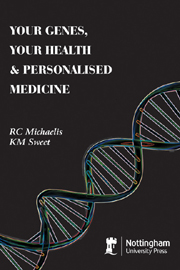Book contents
- Frontmatter
- Contents
- INTRODUCTION
- 1 UNDERSTANDING THE MEANS BY WHICH OUR GENES INFLUENCE OUR HEALTH
- 2 THE MECHANISM WHEREBY A GENE MAKES ITS PROTEIN
- 3 UNDERSTANDING THE PRINCIPLES OF INHERITANCE
- 4 USING YOUR FAMILY HISTORY INFORMATION TO PREDICT YOUR RISK FOR SPECIFIC DISEASES
- 5 USING GENETIC TESTING TO MAINTAIN YOUR HEALTH AND PERSONALISE YOUR MEDICAL CARE, NOW AND IN THE FUTURE
- 6 MAKING THE DECISION WHETHER OR NOT TO HAVE GENETIC TESTING, AND INTERPRETING THE RESULTS OF TESTS YOU CHOOSE TO HAVE PERFORMED
- 7 NUTRIGENOMICS AND EPIGENETICS: THE EFFECTS OUR DIET, ENVIRONMENT AND LIFESTYLE HAVE ON OUR GENES AND PROTEINS
- EPILOGUE AND USEFUL INTERNET RESOURCES
- INDEX
2 - THE MECHANISM WHEREBY A GENE MAKES ITS PROTEIN
- Frontmatter
- Contents
- INTRODUCTION
- 1 UNDERSTANDING THE MEANS BY WHICH OUR GENES INFLUENCE OUR HEALTH
- 2 THE MECHANISM WHEREBY A GENE MAKES ITS PROTEIN
- 3 UNDERSTANDING THE PRINCIPLES OF INHERITANCE
- 4 USING YOUR FAMILY HISTORY INFORMATION TO PREDICT YOUR RISK FOR SPECIFIC DISEASES
- 5 USING GENETIC TESTING TO MAINTAIN YOUR HEALTH AND PERSONALISE YOUR MEDICAL CARE, NOW AND IN THE FUTURE
- 6 MAKING THE DECISION WHETHER OR NOT TO HAVE GENETIC TESTING, AND INTERPRETING THE RESULTS OF TESTS YOU CHOOSE TO HAVE PERFORMED
- 7 NUTRIGENOMICS AND EPIGENETICS: THE EFFECTS OUR DIET, ENVIRONMENT AND LIFESTYLE HAVE ON OUR GENES AND PROTEINS
- EPILOGUE AND USEFUL INTERNET RESOURCES
- INDEX
Summary
Your genes make your proteins, and your proteins perform many of the functions that are required for you to remain healthy. This means that, in order to understand the means by which your genes influence your health, you need to know a little bit about the process by which your genes make your proteins. In this chapter, we present the essential details of this process. Understanding this material will enable you to understand how testing one of your gene's sequences can give you information about your risk for a specific disease, or about your risk for a dangerous side effect from a given prescription drug. It will enable you to understand not only what information the new genetic tests will provide, but also the limitations of that information.
As you read through this chapter, keep the following overview in mind:
Your genes make your proteins, and your proteins perform many of the functions that are required to keep you healthy. Your proteins all need to work at certain levels of activity in order to maintain your health.
A protein is made by chaining amino acids together. There are 20 amino acids that are used to make your proteins. Each amino acid has a unique chemical structure. Some are positively charged, others are negatively charged and some are electrically neutral. The sequence of a gene determines which amino acids will be chained together to make that gene's protein.
In order for a protein to perform its function, and to work at the proper level of activity, it must be able to adopt its characteristic three-dimensional (3D) shape, and to move to some degree as it works. If the sequence of the gene changes, this sometimes (but not always) changes the sequence of amino acids in the gene’s protein. If the sequence of amino acids in the protein changes, this may change the protein’s 3D shape or its ability to move. This may reduce, completely do away with, or even increase the protein’s level of activity.
The genetic factors that influence your risk for specific diseases come from the fact that the sequence of a typical gene is highly variable. Different people often have slightly different versions of a given gene’s sequence. This means that different people often have different levels of activity in the protein that gene makes. Because your proteins perform many of the functions that are required to keep you healthy, if you have a level of activity in any given protein that is significantly greater than or less than that of the typical person, your risk for any diseases that protein’s function influences will be greater or less than the typical person’s risk.
- Type
- Chapter
- Information
- Your Genes, Your Health and Personalised Medicine , pp. 25 - 42Publisher: Nottingham University PressPrint publication year: 2011



